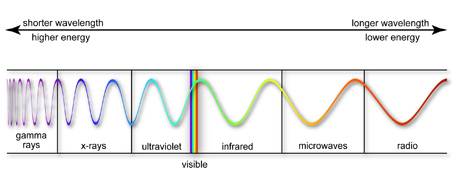Lessons Overview : Light & the Electromagnetic Spectrum
There are two basic forms of waves in nature: mechanical waves and electromagnetic waves. Mechanical waves are more familiar to us in everyday experiences. Some examples of mechanical waves are waves on water, sound waves in air, and fields of wheat waving in the wind. Mechanical waves require a medium through which to travel. Without the ocean, there would be no ocean waves. Without wheat, the wind could not blow waves through it.Visible light is just one example of an electromagnetic wave. Electromagnetic waves are special because they do not require a medium. That is, they can travel through both empty space and various forms of matter
Gamma rays, X-rays, ultraviolet light, visible light, infrared light, microwaves, and radio waves are all forms of electromagnetic waves (also called radiation). Collectively, these types of electromagnetic waves make up the electromagnetic spectrum based upon their differing wavelengths.
The wavelength of radiation influences its energy. Shorter wavelength forms of electromagnetic waves, like gamma rays, X-rays, and ultraviolet rays, carry high energy and are harmful to living creatures. Longer wavelength forms, like radio waves, carry low energy and are not harmful.

It should be emphasized, however, that the distinctions between types of radiation are not exact. There is much overlap between categories. The diagram above represents a continuous spectrum of electromagnetic radiation.